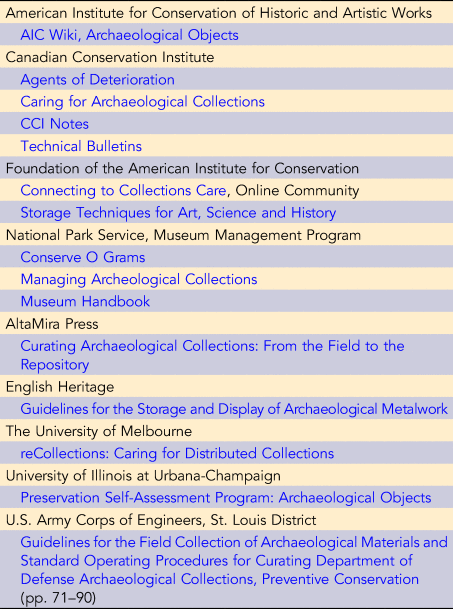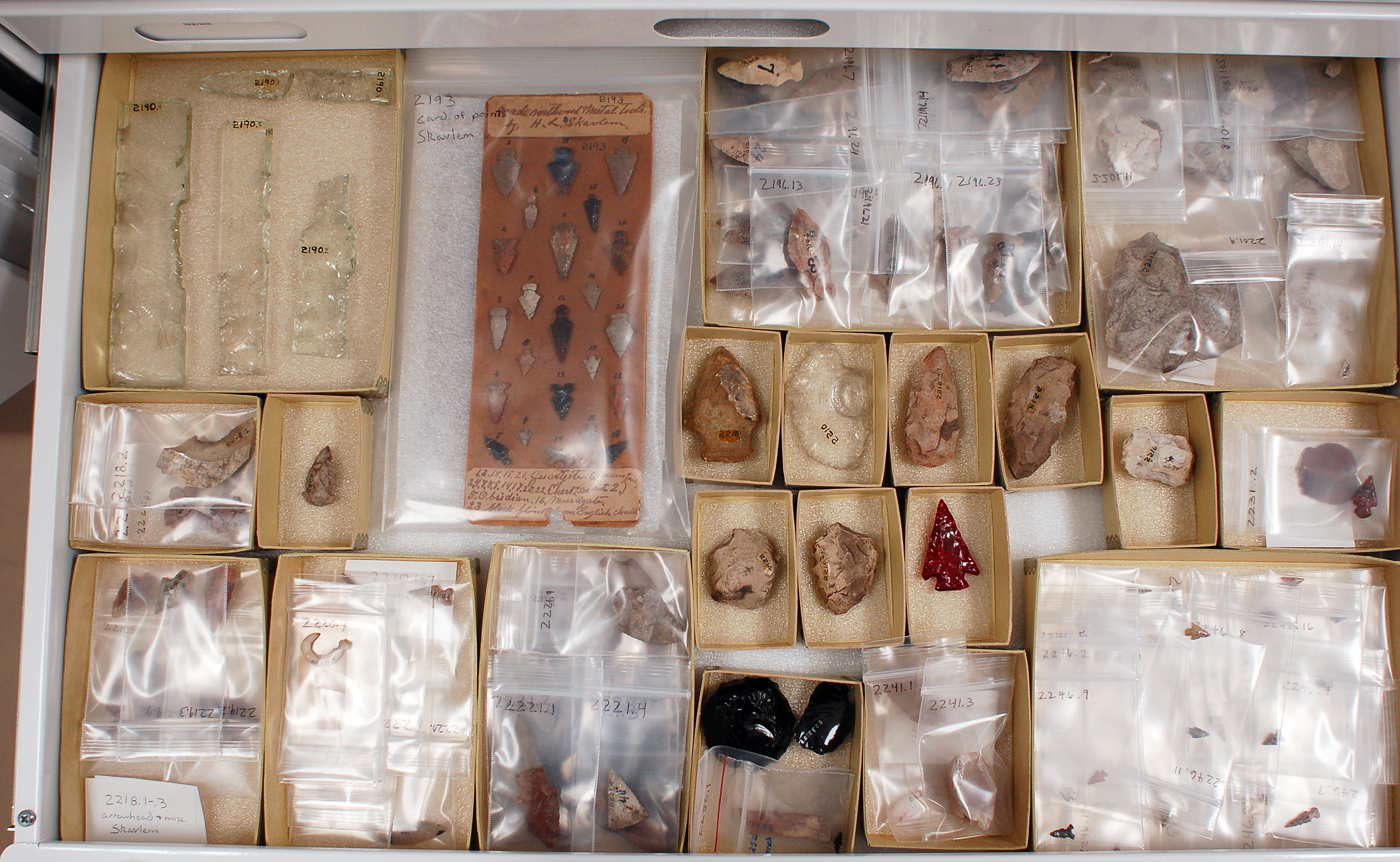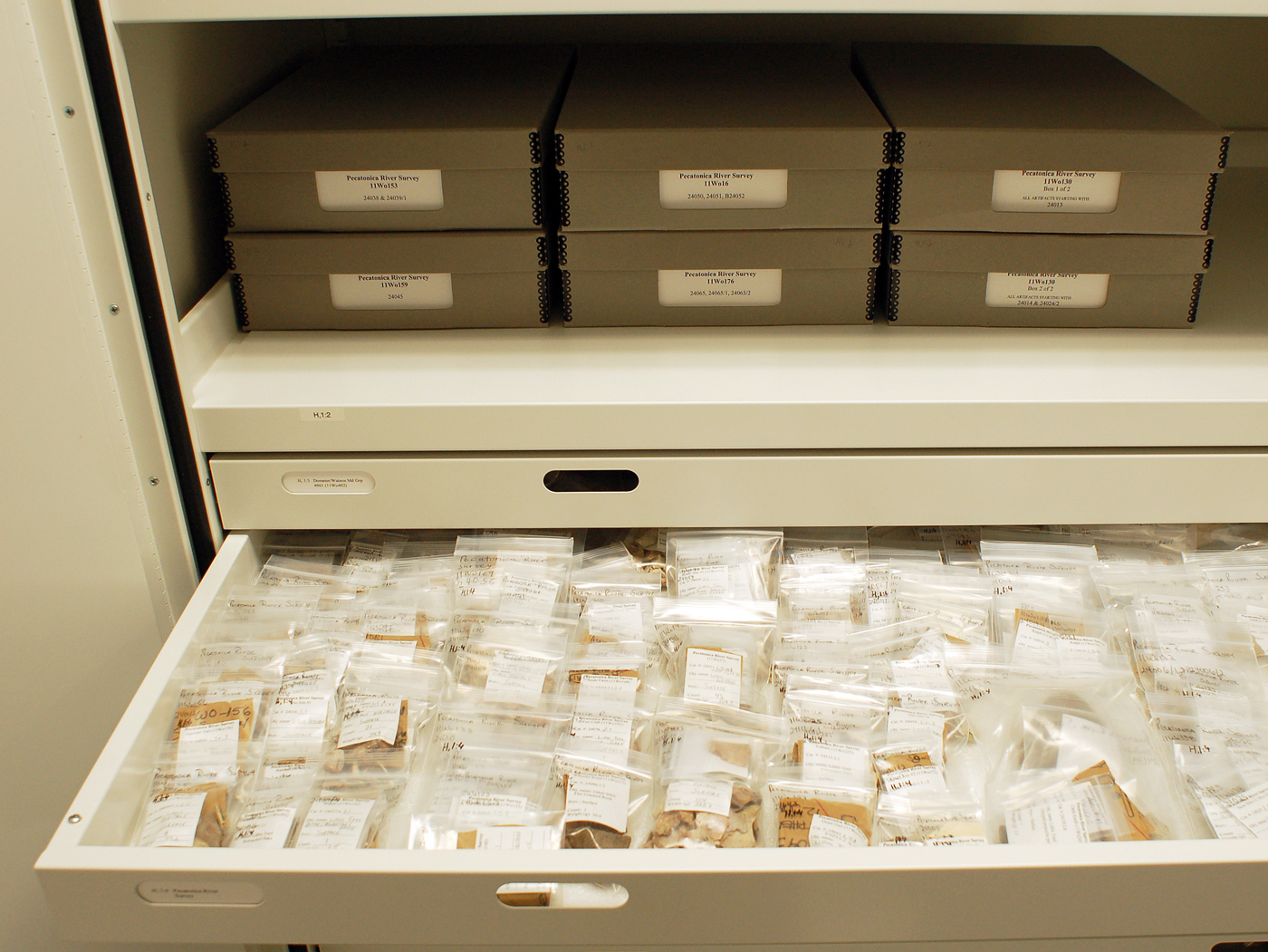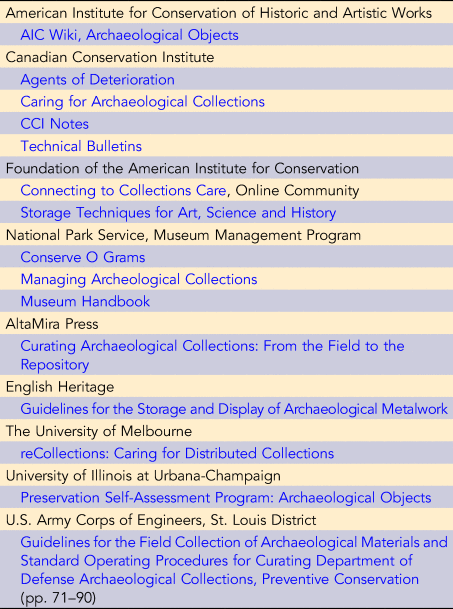In 2016, the Archaeological Collections Consortium (ACC) offered working definitions of key terms used in archaeology. The ACC glossary acknowledges that definitions may vary among users (Archaeological Collections Consortium 2016). This holds true when we consider the terms “preservation” and “conservation.” Childs (Reference Childs, Agnew and Bridgland2006:204) notes, “Preservation and conservation—these two words are widely used among professional archaeologists but usually regarding archaeological sites, not the unique, permanent, and irreplaceable collections recovered from them.” In the museum and preservation communities, the word “preservation” refers to actions taken to slow or prevent deterioration or damage to cultural property (Cato et al. Reference Cato, Golden and McLaren2003:281).
Preventive conservation, or preventive care, is a methodology that works to mitigate deterioration and damage of objects by formulating and implementing holistic policies, plans, and procedures. “Holistic,” in this sense, denotes infusion of preventive conservation principles in all facets of collections management, such as handling, access, exhibition, loan, digitization and digital preservation, integrated pest management, and disaster preparedness. Likewise, while not the focus of this article, preventive care principles also apply to associated documentation and digital data management. Preventive care requires an understanding of what causes deterioration and being able to determine the probability of damage. In short, preventive care works to mitigate the impact of agents of deterioration (Cato et al. Reference Cato, Golden and McLaren2003:282). Conservation, on the other hand, applies science to the examination and physical or chemical treatment of objects (Cato et al. Reference Cato, Golden and McLaren2003:87–88). Conservators usually have specialized training in a particular type of object, such as paintings, paper, metals, or textiles. Collections specialists (curators, registrars, collections managers, collection technicians, etc.) are generally not trained as conservators. Their focus is preventive conservation, and they are trained in mitigating the agents of deterioration. Most collecting institutions do not have conservators on staff, and 80% of institutions do not have paid staff dedicated to collections care (Heritage Preservation 2005:8). This is why preventive care is so important and should be a shared responsibility among those who generate, steward, and research collections.
THE NEED FOR CROSS-TRAINING
Introducing students to these collections, and to the loss of research potential that they represent, helps them understand that our responsibility to protect the research potential of archaeological sites does not end with their excavation (Jenks Reference Jenks2014:35).
In the same way that definitions of terms can vary between professions, institutions, and disciplines, the primary concerns of those seeking access to archaeological collections differ from those who manage archaeological collections. In other words, concerns vary according to perspective. Tammy Stone (Reference Stone2018) offers an excellent example of how different perspectives can affect access to archaeological collections. She explains that whereas archaeologists often think first about cultural and archaeological context, collection professionals first think of objects and their preservation needs (Stone Reference Stone2018:2). Archaeological collections are not curated as a single unit. Documentation (paper vs. born digital), images (negatives vs. color prints vs. black-and-white prints), and objects of different material types can be stored separately because of material-specific preservation and storage needs. Understanding the rationale behind curation and storage schemes will facilitate access to and use of these collections. This is but one reason why archaeologists need cross-training in preventive care, collections management, and curation. Unfortunately, archaeology students are rarely exposed to training in these areas (Longford Reference Longford and Terry Childs2004).
In 1999, the Society for American Archaeology's Committee on Curriculum devised seven principles for archaeological curricular reform (Davis et al. Reference Davis, Altschul, Bense, Brumfiel, Lerner, Miller, Steponaitis and Watkins1999). The importance of stewardship is the first principle. It is framed primarily in terms of the inherent value of non-renewable archaeological resources but has since been expanded to include artifact preservation and the management of collections and data. “Stewardship applies as much to the management of collections and data as to the management of sites” (Jenks Reference Jenks2014:35). Despite the importance of this curricular principle, education about stewardship is poorly represented in archaeology syllabi (Huld Sigurðardóttir Reference Huld Sigurðardóttir, Agnew and Bridgland2006; Kamp Reference Kamp2014). An informal survey conducted in 2006 looked at archaeology curricula in universities in England, Scandinavia, and the United States and found that of 22 universities, “only four offered courses in collections care” (Huld Sigurðardóttir Reference Huld Sigurðardóttir, Agnew and Bridgland2006:222). A 2014 informal survey rated 98 syllabi on the level of attention each gave to the seven principles for curricular reform. According to Kamp (Reference Kamp2014:30), “Stewardship was the least emphasized principle.”
Given that more than 85% of all archaeologists in the United States work in the cultural resources management industry (Doelle and Altschul Reference Doelle and Altschul2009) and that compliance work generates collections that must be curated in designated repositories, there is greater need for archaeologists to receive cross-training in preventive conservation and curation. According to Childs and Benden (Reference Childs and Benden2017:20), “Problems associated with the curation crisis often relate to the general lack of formal collections management and curation training for professional archaeologists.” Literature about preventive care and conservation is abundant, but it is in publications most archaeologists do not refer to or are not aware of, which results in a loss of intersections and an under-use of important resources.
Although CRM is the primary source of employment for archaeologists, recent survey data indicate that 32% of anthropology undergraduate and graduate students consider careers in libraries or museums (Ginsberg Reference Ginsberg2016:7). Teaching and training that elucidates the intersections of archaeology and museums will better prepare students to navigate career options.
Preventive conservation involves equal parts theory and practice. This overview of preventive care and the agents of deterioration is meant to raise awareness of the theory and serve as a point of departure for further investigation. Table 1 provides a list of online or easily accessible resources. Most are free, but students should supplement the knowledge gained through those resources with hands-on practice, such as attending training sessions and workshops at professional conferences and by taking professional development courses taught by conservation, museum, and archaeology professionals. The Society for American Archaeology's online seminar series, the National Center for Preservation Technology and Training workshops, and courses offered through preservation training programs such as the Center for Collections Care at Beloit College are a few opportunities for knowledge-based and hands-on training.
TABLE 1. Links to Key Preventive Care Resources by Publishing Organization.

PREVENTIVE CARE: UNDERSTANDING THE AGENTS OF DETERIORATION
Collections care and preservation have a long, well-documented history. An important paradigm shift in the 1990s ushered in a holistic, risk-based understanding of preventive care (Caple Reference Caple2011). This shift became the framework to preserve museum collections that was published by the Canadian Conservation Institute in 1994. Presented as a matrix, the agents of deterioration are referenced alongside levels of control, building features, portable fittings, and procedures (Canadian Conservation Institute 1994). Each level breaks down the threats to objects and provides strategies for how to avoid, block, detect, and respond to those agents. The framework is a useful tool for identifying the greatest threats to objects and the methods that control those threats.
The agents of deterioration are the ten factors that contribute to deterioration of objects. They can affect the physical and chemical integrity of an object, compromising its value for research, education, and exhibition. The agents of deterioration are well documented (Caple Reference Caple2011; Fifield et al. Reference Fifield, Arenstein and Gleeson2013; Ogden Reference Ogden2004; Rose and Hawks Reference Rose, Hawks, Rose, Hawks and Genoways1995) and are presented here in abbreviated form.
Physical force includes shock, vibrations, abrasions, gravity, and improper handling. Cumulative physical force results from improper handling, improper supports, or overcrowding. It can cause abrasions, cracks, chips, mechanical stress, and other types of physical damage. Catastrophic physical force results from a natural event, such as an earthquake, or from facility or hardware collapse, shipping disasters, or construction vibrations. Vibrations can cause unsecured objects to “walk” off shelves. Physical force can be mitigated by avoiding unnecessary handling, alleviating overcrowding, using proper support mounts, and having a disaster preparedness plan.
Water can derive from natural sources, mechanical malfunctions, or accidents. Natural sources include floods and hurricanes, but more often, water enters storage areas as a result of mechanical malfunctions. Examples include leaking pipes or roofs, sewer backup, overflowing bathrooms, malfunctioning fire suppression systems, clogged drains, and condensation from seasonal fluctuations or imbalanced climate control systems. Mitigation of water events requires regular inspection of storage areas; the use of water alarms on floors; storage furniture that keeps collections at least three to six inches off the floor; repair and sealing of roofs, floors, and walls; and environmental monitoring to ensure stable relative humidity.
Light radiation is divided into three categories: ultraviolet (UV), infrared (IR), and visible light. All are forms of energy that can initiate chemical reactions in both organic and inorganic objects. UV and visible light produce high-energy radiation that results in deterioration via fading, darkening, or yellowing or the breakdown of molecular bonds. IR causes damage by means of excessive heating, which accelerates chemical reactions. The most important things to remember about light-induced damage are that it is affected by duration and intensity, is cumulative, and is irreversible. Light can be mitigated by eliminating daylight, using UV filters on UV-producing light sources (such as fluorescent bulbs), decreasing the duration and intensity of exposure, and storing collections in enclosures or cabinets.
Maintaining the appropriate relative humidity (RH) and temperature for archaeological objects is important because after they are removed from the relative equilibrium of the archaeological environment, damage can occur as objects respond to changes in humidity and temperature. In general, excessive heat and humidity increase the rate of deterioration, produce conditions suitable for mold growth (above 70% RH), and offer a welcoming environment for pests. Temperatures and RH that are too low can result in dehydration and embrittlement. Organic materials are hygroscopic, meaning they can absorb and desorb water, so fluctuations in the environment can also result in physical damage. For the majority of cultural materials, a set point in the range of 45%–55% RH with an allowable drift of ± 5% and a temperature range of 59°F–77°F is acceptable (Hatchfield Reference Hatchfield2011:52). However, low humidity (below 40%) is recommended for metals.
Pests include any living organism that can damage material culture. Insects, vermin, and mold are the most common. To mitigate pests, one must remove the factors that pests require for survival, which include food, moisture, habitat, and warmth. For these reasons, food and drink are not allowed near collection labs and storage areas. Those areas must be cleaned and inspected regularly, and environmental controls should maintain temperature and humidity at levels that are not conducive to pest survival. An integrated pest management program should include regular monitoring via sticky traps, staff training to identify harmful insects, and measures to minimize the factors pests need for survival.
A broad range of substances can chemically react with objects and result in disintegration, discoloration, corrosion, or embrittlement. These contaminants, or pollutants, come in different forms—including gases, liquids, and solids—and derive from both indoor and outdoor sources. Greasy deposits from soiled hands are an example of liquid contaminants. Dust and salts, which may migrate or effloresce from archaeological ceramics, are examples of particulate or solid contaminants. Contaminants can be mitigated by having good ventilation, vapor barriers and dust covers, enclosures and storage cabinets, good housekeeping, and inert archival materials.
The final three agents of deterioration are fire, theft, and curatorial neglect. Flames, heat, soot, smoke, and hot gases have a devastating effect on collections. Buildings with fire and smoke detectors, sprinkler systems, and facilities where collections are stored in cabinets will experience less loss in the event of a fire.
Theft and vandalism are frequently associated with art collections, but archaeological collections are also at risk because artifacts are often small and portable and may have value on the antiquities market. Theft is often opportunistic, which is why limited access, proper security, and a comprehensive inventory are essential. Vandalism generally occurs because someone takes issue with an institution or subject matter, but it can also occur as a result of mental illness or drug use.
The final agent of deterioration is dissociation and curatorial neglect. Dissociation refers to objects being placed in the incorrect storage location or simply being lost in a facility. This can happen to objects or records. Curatorial neglect can include abandonment of collections resulting in orphaned collections, negligence resulting in loss of objects or related data, ignorance, and lack of adequate policy and procedures regarding handling and use. Dissociation and curatorial neglect can be mitigated through object movement protocols, staff training in preventive care, and collections stewardship policy and procedures.
GENERAL GUIDELINES FOR STORAGE
Storage happens after collections have been acquired, accessioned, and cataloged. Storage decisions should strive to balance preservation with access. Understanding how storage practices can mitigate the agents of deterioration is essential because objects spend most of their time in storage. Good storage provides multilayered protection involving successive protective envelopes or enclosures. These layers include the building or facility, storage room, storage furniture, storage container, and storage materials. Each offers successive levels of containment, buffering objects from the agents of deterioration (National Park Service 2012:1–2).
At the building level, location is key, meaning buildings should be in areas not prone to flooding and far from industrial and urban contaminants and should be designed so that facility functions do not put collections at risk. For example, mechanical systems should not run through storage areas; food service or disposal, loading docks, flotation and artifact washing areas, and exhibit shops (i.e., “dirty” areas) should not be near storage areas; and storage should not be located in basements, on top floors, next to exterior walls, or under bathrooms or mechanical rooms because of the potential of water damage. Storage areas should have no windows, be away from areas of public access, and integrate environmental controls and security. Collections management and research workspaces should be separate from storage, and storage areas should be easy to monitor and clean (Bachmann and Rushfield Reference Bachmann, Rushfield and Bachmann1992; Hilberry Reference Hilberry, Rose, Hawks and Genoways1995). Storage areas may be organized on disciplinary standards (Latham and Simmons Reference Latham and Simmons2014:57; i.e., art collections are often organized by genre or medium whereas anthropology museums are organized by material composition, geographic origin, or cultural affiliation), traditional care needs (Clavir and Moses Reference Clavir and Moses2018; Drumheller and Kaminitz Reference Drumheller and Kaminitz1994; Flynn and Hull-Walski Reference Flynn and Hull-Walski2001), or climate control and security requirements.
Storage of collections in archival quality storage furniture is crucial to mitigating the agents of deterioration. Storage furniture should organize space efficiently, facilitate access to collections, provide physical support, be flexible and adjustable, and provide protection from environmental fluctuations. Generally speaking, storage equipment falls into two categories: open or closed. Open systems include pallets for oversized or very heavy objects, shelving units, brackets or racks, and vertical screens primarily used for framed works of arts. Closed storage includes cabinets, flat files, and mobile compactor storage systems. Factors such as cost, access, security, staffing levels, and type of collection need to be considered when choosing storage furniture. Storage furniture can be ready-made (modular) or custom built. Storage furniture must be inert, meaning the materials the furniture is made from do not react with other substances they come in contact with. For this reason, wood and wood products should be avoided because they emit organic acids that harm many objects. Ideally, cabinets should be constructed of steel with a white powder-coated finish (Moore and Williams Reference Moore, Williams, Rose, Hawks and Genoways1995; Ogden Reference Ogden2004).
Objects may be placed in containers (boxes or trays) or in custom mounts before being placed in storage. Containers and mounts should provide physical support, decrease direct handling, immobilize weak or damaged components, and facilitate visual accessibility (Figure 1). Storage materials must be inert, nonabrasive, strong enough to support the weight of the object, and sufficiently durable to withstand handling (Barclay et al. Reference Barclay, Bergeron and Dignard1998). Individualized storage of archaeological collections is rarely feasible or cost effective. For this reason, lithic debitage, soil samples, faunal remains, and body sherds are frequently stored as lots, often in 4 mil polyethylene bags or archival boxes (Figure 2). Lithic tools, ground or polished stone, and rim sherds or other diagnostic sherds may be bagged individually or placed in recess mounts carved from Ethafoam® plank or Volara® (Figure 3). Both are polyethylene foam products, but Volara® has an extremely soft surface compared to Ethafoam®, especially when cut. If cavities are carved from Ethafoam®, they must be lined with a soft, nonabrasive material like Tyvek® soft wrap or Teflon® to prevent abrasions. Overcrowding of archaeological collections in storage containers can result in physical damage. Edge wear on stone tools offers important analytical data, but if lithics are piled together in a box or bag or move freely in drawers as they open and close, abrasion and chipping will compromise future research potential. Small metal objects can be stored in custom silica gel microenvironments (i.e., a clear polyethylene box with snap fit lid or in a custom enclosure made from vapor barrier films) to control moisture in the environment and avoid corrosion (Brown Reference Brown2010; Rimmer et al. Reference Rimmer, Thickett, Watkinson and Ganiaris2013). Whole ceramic vessels should be supported by polyethylene foam ring mounts, and it may be necessary to create custom containers for reconstructed vessels or figures because glue bonds frequently shrink and weaken over time.

FIGURE 1. Experimental archaeology collection of lithic and glass objects stored in boxes and polyethylene bags to increase visual accessibility. Photo by Nicolette B. Meister.

FIGURE 2. Archaeological collections stored in metal-edged boxes and polyethylene bags by material type and intrasite provenience. Photo by Nicolette B. Meister.

FIGURE 3. Banded slate bannerstone from Milwaukee County, Wisconsin, recessed in Volara®. Photo by Nicolette B. Meister.
CONCLUSIONS
This guide focuses on preventive care of archaeological objects. However, collections are more than assemblages of objects. According to Childs and Benden (Reference Childs and Benden2017:17), “Collections are generated when archaeologists remove physical objects from the ground and create associated records to document a project.” As a result, archaeological collections include proposals, permits, field notes, maps, reports, photographs, and born-digital media. Each component must be managed, preserved, and made accessible, which involves multiple stakeholders. Sustainable management of archaeological collections has proven challenging because of the rapid growth of collections recovered, a shortage of storage space, and the human and financial resources available (Childs Reference Childs, Smith and Murray2011). However, recent literature has introduced a more holistic, systems-based way of understanding the stages and stakeholders involved in curating archaeological collections. The Collections Management Cycle offered by Childs and Benden (Reference Childs and Benden2017) is one such example. Their conceptual framework for curating new archaeological collections makes clear the interrelationships between archaeological project management and recovered collections (Childs and Benden Reference Childs and Benden2017:13). Like collections management, preventive care can be understood as a cycle involving multiple stakeholders. Preventive conservation begins in the field and should be deployed continually through the lifespan of a collection.
Archaeologists have an ethical obligation to preserve the data they collect. However, their focus is not always oriented toward the long-term preservation of and access to collected objects and associated documentation. Cross-training in preventive care is essential for emerging archaeological professionals because they generate archaeological collections, conduct research using those collections, and teach subsequent generations of archaeologists. Approaching preventive care as outlined here is a step toward meeting these stewardship responsibilities.
Acknowledgments
This thematic issue grew out of a symposium on archaeological collections care organized by Danielle Benden and Michelle Knoll for the 2018 Annual Meeting of the Society for American Archaeology. I wish to thank them, as well as the other authors who contributed to this issue, for their sustained commitment to archaeological collections care and management. Special thanks to William Green for his support and editorial feedback on an earlier version of this article and to Gabriela Cerghendean, who provided the Spanish abstract translation. I am also grateful to the anonymous reviewers who provided thoughtful comments and suggestions.
Data Availability Statement
No original data are presented in this paper.






